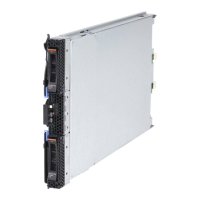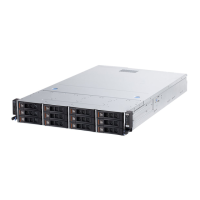74 IBM eX5 Implementation Guide
3.7 Processor options
The x3850 X5 is supported with two, three, or four processors. Table 3-9 shows the option
part numbers for the supported processors. In a 2-node system, you must have eight
processors, which must all be identical. For a list of the processor options available in this
solution, see 2.2, “Intel Xeon 6500 and 7500 family processors” on page 16.
Table 3-9 Available processor options for the x3850 X5
With the exception of the E7520, all processors listed in Table 3-9 support Intel Turbo Boost
Technology. When a processor operates below its thermal and electrical limits, Turbo Boost
dynamically increases the clock frequency of the processor by 133 MHz on short and regular
intervals until an upper limit is reached. See 2.2.3, “Turbo Boost Technology” on page 18 for
more information.
With the exception of the X7542, all of the processors that are shown in Table 3-9 support
Intel Hyper-Threading Technology, which is an Intel technology that can improve the
parallelization of workloads. When Hyper-Threading is engaged in the BIOS, for each
processor core that is physically present, the operating system addresses two. For more
information, see 2.2.2, “Hyper-Threading Technology” on page 17.
All processor options include the heat-sink and CPU installation tool. This tool is extremely
important due to the high possibility of bending pins on the processor socket when using the
incorrect procedure.
The x3850 X5 includes at least two CPUs as standard. Two CPUs are required to access all
seven of the PCIe slots (shown in Figure 3-7 on page 66):
Either CPU 1 or CPU 2 is required for the operation of PCIe slots 5-7.
Either CPU 3 or CPU 4 is required for the operation of PCIe Slots 1-4.
All CPUs are also required to access all memory cards on the x3850 X5 but they are not
required to access memory on the MAX5, as explained in 3.8, “Memory” on page 76.
Part
number
Feature
code
Intel Xeon
model
Speed Cores L3 cache GT/s/
Memory speed
a
a. GT/s is gigatransfers per second. For an explanation, see 2.3.1, “Memory speed” on page 22.
Power
(watts)
HT
b
b. Intel Hyper-Threading Technology. For an explanation, see 2.2.2, “Hyper-Threading Technology” on page 17.
TB
c
c. Intel Turbo Boost Technology. For an explanation, see 2.2.3, “Turbo Boost Technology” on page 18.
49Y4300 4513 X7560 2.26 GHz 8 24 MB x6.4/1066 MHz 130 W
Ye s Ye s
49Y4302 4517 X7550 2.00 GHz 8 18 MB x6.4/1066 MHz 130 W
Ye s Ye s
59Y6103 4527 X7542 2.66 GHz 6 18 MB x5.86/978 MHz 130 W No
Ye s
49Y4304 4521 E7540 2.00 GHz 6 18 MB x6.4/1066 MHz 105 W
Ye s Ye s
49Y4305 4523 E7530
d
d. Scalable to a 4-socket maximum, and therefore, it cannot be used in a 2-node x3850 X5 complex that is scaled
with native QPI cables.
1.86 GHz 6 12 MB x5.86/978 MHz 105 W
Ye s Ye s
49Y4306 4525 E7520
d
1.86 GHz 4 18 MB x4.8/800 MHz 95 W Ye s N o
49Y4301 4515 L7555 1.86 GHz 8 24 MB x5.86/978 MHz 95 W
Ye s Ye s
49Y4303 4519 L7545 1.86 GHz 6 18 MB x5.86/978 MHz 95 W
Ye s Ye s

